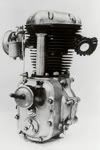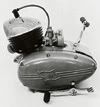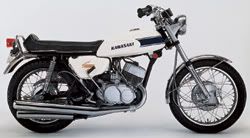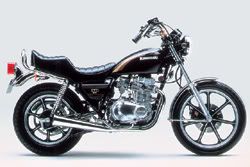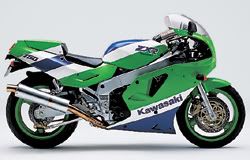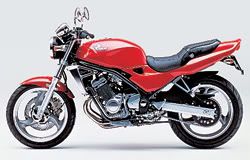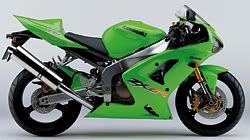More than forty years have passed since Kawasaki started full-scale production of motorcycles. Our first motorcycle engine was designed based on technical know-how garnered from the development and production of aircraft engines.
Our entry into the motorcycle industry was driven by Kawasaki’s constant effort to develop new technologies. Over the years we have released numerous new models that have helped shape the market, and in the process, created many enduring legends based on the speed and power of our machines. In 1996, we produced our 10 millionth vehicle, a testament to Kawasaki’s ability to meet the needs of a wide range of riders. As Kawasaki continues to "Let the good times roll," our latest challenges will surely give birth to new legends.
These are the motorbike engines produced in 1952 and 1955.
Design of the KE- 1 motorcycle Engine is completed. (Kawasaki Machine Industry (the precursor to Kawasaki Aircraft Company), Takatsuki factory)."Aircraft engineers" began the development of the KE (Kawasaki Engine) in 1949. Mass production starts in 1953. The air-cooled, 148cc, OHV, 4-stroke Single has a maximum power of 4 PS at 4,000 rpm.
Production of the KB-5 Motorcycle Engine starts. (Kawasaki Aircraft Company, Kobe Plant).Its responsive torque at low and mid rpm, and outstanding characteristics give it a good reputation among riders. For the next 10 years the KB-5 received a number of updates and provided the base for Kawasaki’s 125cc motorcycle engine.In the same year, the Meihatsu 125-500 was released, equipped with the KB-5engine.
~
Kawasaki motorbikes that have been sold all around the world from 1950's till now.
~
1950's
Meihatsu 125 Deluxe was said to be " A Durable Kawasaki Engine"The Meihatsu 125 Deluxe (Kawasaki Meihatsu Industries) achieved a top speed of 81.5 km/h at a motorcycle industry magazine test, setting a record for its category. In a separate test the Kawasaki engine proved phenomenal durability by running for 50, 000 km without breaking down.
~
1960's
In 1968 sales of the H1 (500cc) (500SS Mach-III in Japan) commenced. The air-cooled 2-stroke triple cylinder is the fastest machine in its class with a top speed of 200km/h. Nicknamed "Bronco", the H1 marked the beginning of Kawasaki’s Speed King Legend.
Expectant World Champion ShinesIn the FIM World Road Racing 125cc Championship, Dave Simmons scored victories in both the West German GP and the Isle of Mann TT and won the series championship on his KR-1.
Expectant World Champion ShinesIn the FIM World Road Racing 125cc Championship, Dave Simmons scored victories in both the West German GP and the Isle of Mann TT and won the series championship on his KR-1.
~
1970's
Also in the same year, the first Japanese mass-produced belt-driven motorcycle, the KZ440LTD, was manufactured for the US market. This was one example of Kawasaki’s "Spirit of Embracing Challenge".
~
1980's
In 1989 sales of the ZXR Series, including the ZXR750 and the ZXR400, commenced. These supersport machines had styling identical to that of the Kawasaki works racers.In the same year sales of the Zephyr (400cc) commenced.
~
1990's
In 1991 sales of the Balius (250cc) commenced. The new naked sports model featured a liquid-cooled DOHC 4-cylinder engine.
~
2000's
Sales of the Ninja ZX-6R (636 cm3) and the Ninja ZX-6RR (600 cm3) commence. Designed to be the quickest circuit bikes in their class, these completely redesigned Sixes feature many components usually found only on race machines.
